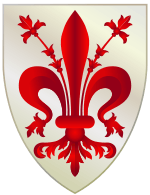Santa Trinita
Santa Trinita ("Holy Trinity") is a church in central Florence, Italy. It is the mother church of the Vallumbrosan Order of monks, founded in 1092 by a Florentine nobleman. Nearby is the Ponte Santa Trinita over the river Arno.
The church is famous for its Sassetti Chapel, containing notable frescoes by Domenico Ghirlandaio, ranked amongst 15th-century painting's masterworks, and the Bartolini Salimbeni Chapel, with frescoes by Lorenzo Monaco.
Even though the Italian word for "trinity" is trinità, with an accent indicating stress on the last vowel, the Florentine pronunciation puts the stress on the first vowel, and the name is therefore written without an accent; sometimes, it is accented as trìnita to indicate the unusual pronunciation.
History
The current church was constructed in 1258–1280 over a pre-existing 11th-century church. Multiple reconstructions occurred thereafter. The Mannerist façade (1593–1594) was designed by Bernardo Buontalenti. The relief over the central door of the Trinity was sculpted by Pietro Bernini and Giovanni Battista Caccini. The 17th century wooden doors were carved to recall saints of the Vallumbrosan order. The Column of Justice in the Piazza outside, originates from the Baths of Caracalla, and was a gift to Cosimo I de' Medici by Pope Pius IV. It was used in 1565 to commemorate the Battle of Montemurlo.
The Santa Trinita Maestà by Cimabue was once at the high altar of the church, and was later moved to a side chapel. It is now exhibited at the Uffizi.
Chapels
The church has approximately 20 chapels, which contain a noteworthy amount of artworks. The most significant are the Sassetti and the Bartolini Salimbeni Chapels, which contain frescoes by Domenico Ghirlandaio and the 15th-century artist Lorenzo Monaco, respectively. Francesco Sassetti had been a manager of the Medici Bank. The Ghirlandaio frescoes use as backgrounds the then contemporary Florentine city views.
| Side | Chapel # | Chapel name and artworks |
|---|---|---|
| R | 1 (nave near facade) | The Gianfigliazzi chapel remodeled around 1630 by Gherardo Silvani contains a 14th-century crucifix (Crocifisso della Providenza) and a fresco of St. Mary of Egypt & St. Zosimus (c. 1400). |
| R | 2 | The Davizzi chapel remodeled c. 1642 by Matteo Nigetti. |
| R | 3 | The Cialli-Sernigi chapel contains a Madonna with Saints by Neri di Bicci and unfinished detached murals of Mystic marriage of St. Catherine by a follower of Spinello Aretino. |
| R | 4 | Bartolini Salimbeni Chapel, containing frescoes of Life of the Virgin (1420s) by Lorenzo Monaco and assistants. An Annunciation altarpiece is also by Lorenzo Monaco. |
| R | 5 | The Ardinghelli chapel contains a 15th-century Man of Sorrows and a tabernacle (1505–15) by Benedetto da Rovezzano. |
| R | 6 (far wall after transept exit) | The Sassetti Chapel has murals of St. Francis and Prophecies of Christ’s Birth (1482–1485), as well as altarpiece of Adoration of the Magi (1485) painted by Domenico Ghirlandaio. Over the entrance is a scene of the Sybil informing emperor Augustus of the coming of Christ. One of the panels depicts the Miracle of St. Francis in resuscitating a boy who had fallen from Palazzo Spini.[1] The Francis Receiving the Order from Pope Honorius is sited in the Piazza della Signoria. |
| R | 7 (far wall) | The Doni chapel was decorated between 1608-40 by Ludovico Cigoli. |
| 8 | The center chancel hold an altarpiece by Mariotto di Nardo depicting the Trinity (1406). | |
| L | 1 (nave) | The Strozzi chapel was rebuilt by Giovanni Battista Caccini and contains damaged murals by Bernardino Poccetti. The altarpiece is now in the Uffizi. Fra Angelico's Deposition, begun by Lorenzo Monaco for the chapel, is now at the National Museum of San Marco. |
| L | 2 | The Bombeni chapel was remodeled by Nigetti, and holds Mystic marriage of St Catherine of Siena by Antonio del Ceraiolo and St. Jerome and Annunciation by Ridolfo Ghirlandaio. |
| L | 3 | The Davanzati chapel contains an Annunciation (c. 1450-60) by Neri di Bicci and a mural of Disputation of St. Catherine by a follower of Maso di Banco. |
| L | 4 | The Compagni chapel has a Coronation of Virgin (c. 1400) and a San Giovanni Gualbert and Vallombrossan saints (1455) painted by Neri di Bicci. |
| L | 5 (transept) | The Spini chapel houses a Magdalen by Desiderio da Settignano and finished by Benedetto da Maiano. |
| L | 6 (transept) | The Chapel of Madonna dello Spasimo has a Christ of the road to calvary by school of Cosimo Rosselli. |
| L | 7 (transept) | The Chapel of San Giovanni Gualberto was designed by Caccini. |
| L | 8 (transept) | The Chapel contains a Trinity adored by Saints Catherine & Mary Magdalen (c. 1485) painted by Francesco Granacci. |
| L | 9 (far wall) | The Scali chapel has a fresco cycle by Giovanni dal Ponte and Smeraldo di Giovanni. The tomb of the bishop Benozzo Federighi was completed by Luca della Robbia.[2] |
| L | 10 (far wall) | Usimbardi chapel rebuilt by Cigoli in 1602. |
Notes
- ↑ Ghirlandaio, Domenico. "Resurrection of the Boy". Web Gallery of Art. Retrieved 10 August 2012.
- ↑ Robbia, Luca della. "Monument to Bishop Benozzo Federighi". Web Gallery of Art. Retrieved 10 August 2012.
References
- Borsook, Eve (1991). The Companion Guide to Florence. New York: HarperCollins. pp. 187–191. ISBN 0-00-215139-1.
External links
| Wikimedia Commons has media related to Santa Trinita (Florence). |
Coordinates: 43°46′13″N 11°15′03″E / 43.770153°N 11.250719°E
